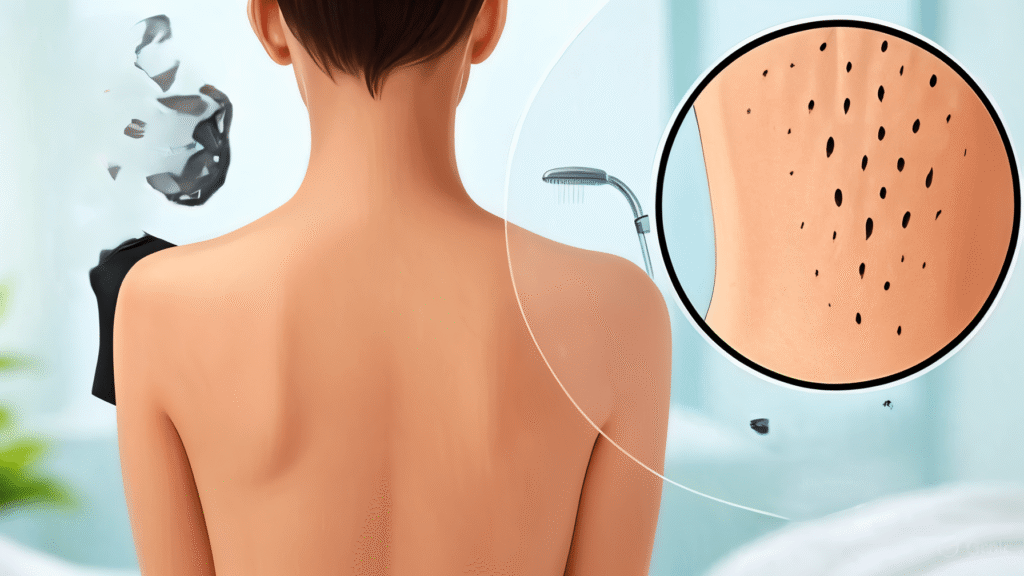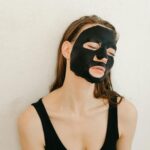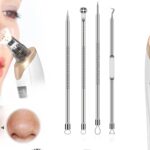Back blackheads, also known as “bacne,” can be frustrating and challenging to treat due to their hard-to-reach location. These stubborn comedones form when hair follicles become clogged with excess oil (sebum), dead skin cells, and bacteria, creating dark spots that can affect your confidence and comfort. Unlike facial blackheads, back blackheads often require specialized treatment approaches and tools to effectively address the unique challenges of treating this area.
What Are Back Blackheads and What Causes Them?
Understanding Blackhead Formation
Blackheads are open comedones that form when pores become clogged with a combination of sebum, dead skin cells, and environmental debris. The dark appearance isn’t actually dirt – it’s the result of oxidation when the clogged material is exposed to air. On your back, these comedones can be particularly persistent due to several factors:
- Increased sebaceous gland activity: The back contains numerous oil-producing glands
- Thicker skin: Back skin is naturally thicker, making it harder for dead cells to shed naturally
- Friction and pressure: Clothing, backpacks, and sleeping positions can worsen clogging
- Limited air circulation: Covered areas trap moisture and bacteria
Primary Causes of Back Blackheads
Hormonal Fluctuations
Androgens, particularly testosterone, stimulate sebaceous glands to produce excess oil. This is why back blackheads often worsen during puberty, menstruation, pregnancy, or times of stress.
Genetic Predisposition
If your parents struggled with back acne or blackheads, you’re more likely to experience similar issues due to inherited skin characteristics and oil production patterns.
Lifestyle and Environmental Factors
- Tight-fitting clothing that traps sweat and bacteria
- Infrequent showering, especially after workouts
- Heavy backpacks or sports equipment
- High-humidity environments
- Certain medications (corticosteroids, lithium)
Dietary Influences
While research is ongoing, some studies suggest that high-glycemic foods and dairy products may contribute to acne formation by influencing hormone levels and inflammation.
Effective Over-the-Counter Treatments for Back Blackheads
Salicylic Acid: The Gold Standard
Salicylic acid is a beta-hydroxy acid (BHA) that penetrates deep into pores to dissolve oil and dead skin cells. For back blackheads, look for:
- Body washes with 0.5-2% salicylic acid: Use daily during your shower
- Leave-on treatments with 2% concentration: Apply after cleansing for targeted treatment
- Exfoliating pads: Convenient for reaching difficult areas
Application Tips for Your Back:
- Use a long-handled applicator or ask a partner for help
- Start with lower concentrations to avoid irritation
- Apply to clean, dry skin and allow full absorption
Benzoyl Peroxide for Bacterial Control
The American Academy of Dermatology recommends benzoyl peroxide emollient foam washes containing 5.3-10% concentration for back acne treatment. This powerful ingredient:
- Kills acne-causing bacteria (Propionibacterium acnes)
- Helps unclog pores by removing dead skin cells
- Reduces inflammation and prevents new blackheads
Proper Application Technique:
- Apply the foam wash to affected areas
- Leave on skin for 2-5 minutes before rinsing
- Start with every other day to build tolerance
- Always follow with a non-comedogenic moisturizer
Retinoids and Adapalene
Adapalene 0.1% gel, now available over-the-counter, is particularly effective for blackhead treatment. This retinoid:
- Normalizes skin cell turnover
- Prevents new comedone formation
- Reduces inflammation
- Improves overall skin texture
Professional Medical Treatments
Chemical Peels for Deep Cleansing
Professional chemical peels using glycolic acid, salicylic acid, or trichloroacetic acid can effectively treat stubborn back blackheads by:
- Removing multiple layers of dead skin cells
- Deeply unclogging pores
- Stimulating new skin cell production
- Improving skin texture and tone
Microdermabrasion and Dermaplaning
These mechanical exfoliation treatments physically remove the top layer of skin, helping to:
- Clear existing blackheads
- Smooth skin texture
- Enhance product penetration
- Stimulate collagen production
Prescription Treatments
For severe cases, dermatologists may prescribe:
- Topical retinoids (tretinoin, tazarotene): Stronger than OTC options
- Oral antibiotics: For inflammatory components
- Hormonal therapy: For women with hormone-related acne
- Isotretinoin: For severe, treatment-resistant cases
Comprehensive Home Remedies and Natural Treatments
Effective DIY Exfoliation Methods
Sugar and Honey Scrub
- Mix 2 tablespoons brown sugar with 1 tablespoon raw honey
- Gently massage in circular motions for 30 seconds
- Rinse thoroughly with warm water
- Use 2-3 times weekly
Baking Soda Treatment
- Create a paste with baking soda and water
- Apply to affected areas for 10-15 minutes
- Rinse with cool water
- Limit use to once weekly to prevent over-drying
Heat Therapy and Steam Treatments
Warm Compress Method
- Soak a clean cloth in warm (not hot) water
- Apply to blackhead areas for 10-15 minutes
- Follow with gentle exfoliation
- Apply treatment products while pores are open
Shower Steam Technique
- Take a hot shower to open pores naturally
- Use this opportunity for gentle exfoliation
- Apply treatments immediately after showering
Natural Antibacterial Treatments
Tea Tree Oil Application
- Dilute 5-10% tea tree oil with a carrier oil
- Apply with a cotton pad or spray bottle
- Use daily for antibacterial benefits
Green Tea Toner
- Brew strong green tea and let cool
- Apply with a spray bottle or cotton pad
- Provides antioxidants and anti-inflammatory benefits
Advanced Application Techniques and Tools
Specialized Tools for Back Treatment
Long-Handled Applicators
- Silicone back scrubbers with extended handles
- Lotion applicators for even product distribution
- Spray bottles for hard-to-reach areas
Back Acne Brushes
- Soft-bristled brushes designed for sensitive skin
- Electric cleansing brushes with back attachments
- Exfoliating mitts for gentle manual exfoliation
Partner-Assisted Treatment
When treating your back, consider enlisting help for:
- Even product application
- Thorough cleansing of all areas
- Monitoring treatment progress
- Applying spot treatments to specific blackheads
Personalized Treatment Approaches by Skin Type
Oily Skin Protocol
- Use salicylic acid cleansers daily
- Apply benzoyl peroxide treatments 3-4 times weekly
- Incorporate clay masks weekly
- Choose oil-free, non-comedogenic products exclusively
Sensitive Skin Modifications
- Start with lower concentrations of active ingredients
- Use fragrance-free, hypoallergenic products
- Introduce new treatments gradually
- Focus on gentle exfoliation methods
Combination Skin Strategy
- Use different products for different areas
- Apply stronger treatments to oilier zones
- Maintain moisture balance with appropriate moisturizers
- Monitor skin response and adjust accordingly
Prevention Strategies and Lifestyle Modifications
Daily Hygiene Practices
Shower Routine Optimization
- Shower immediately after sweating
- Use lukewarm water to avoid over-drying
- Cleanse your back last to prevent product residue
- Pat skin dry rather than rubbing vigorously
Clothing and Fabric Choices
- Wear breathable, natural fabrics like cotton
- Choose loose-fitting clothing when possible
- Wash workout clothes after each use
- Avoid fabric softeners that can clog pores
Environmental and Lifestyle Factors
Sleep Environment
- Change pillowcases and sheets weekly
- Use hypoallergenic, non-comedogenic laundry detergents
- Consider sleeping on your side or stomach less frequently
- Ensure proper bedroom ventilation
Exercise and Activity Modifications
- Wipe down gym equipment before use
- Shower within 30 minutes of exercising
- Wear moisture-wicking fabrics during workouts
- Clean sports equipment and backpacks regularly
Post-Treatment Care and Maintenance
Moisturizing and Skin Barrier Protection
Even when treating blackheads, maintaining skin hydration is crucial:
- Use lightweight, non-comedogenic moisturizers
- Apply sunscreen daily to prevent post-inflammatory hyperpigmentation
- Consider products with niacinamide for additional pore-refining benefits
Long-Term Maintenance Strategies
Gradual Treatment Reduction
Once blackheads clear, gradually reduce treatment frequency while maintaining:
- Regular gentle exfoliation
- Consistent cleansing routine
- Periodic use of active ingredients
Monitoring and Adjustment
- Track skin changes with photos
- Adjust treatments based on seasonal variations
- Maintain consistent product use for best results
When to Seek Professional Dermatological Help
Red Flag Symptoms
Consult a dermatologist if you experience:
- Painful, inflamed cysts alongside blackheads
- Scarring or post-inflammatory hyperpigmentation
- No improvement after 6-8 weeks of consistent treatment
- Severe emotional distress related to skin appearance
Professional Treatment Timeline
Initial Consultation Expectations
- Comprehensive skin assessment
- Discussion of treatment history and preferences
- Customized treatment plan development
- Realistic timeline establishment (typically 3-4 months for significant improvement)
Insurance and Cost Considerations
Many insurance plans cover dermatological treatments for acne when:
- Over-the-counter treatments have failed
- The condition significantly impacts quality of life
- A dermatologist deems medical treatment necessary
Combination Therapy Approaches
Layering Active Ingredients
Morning Routine
- Gentle cleanser
- Benzoyl peroxide treatment
- Non-comedogenic moisturizer
- Broad-spectrum sunscreen
Evening Routine
- Salicylic acid cleanser
- Retinoid treatment (alternate nights)
- Lightweight moisturizer
Professional and At-Home Treatment Integration
Combine professional treatments with home care for optimal results:
- Monthly professional chemical peels with daily at-home retinoids
- Quarterly microdermabrasion with consistent salicylic acid use
- Professional extractions followed by proper home maintenance
Frequently Asked Questions
Q: How long does it take to see results when treating back blackheads?
A: Most people begin seeing improvement within 6-8 weeks of consistent treatment. Complete clearing typically takes 3-4 months, as it takes time for skin cell turnover to normalize and for existing blackheads to work their way to the surface.
Q: Can I use the same products on my back as I use on my face?
A: While many ingredients are the same, back skin is thicker and less sensitive than facial skin. You can often use higher concentrations of active ingredients on your back, and body-specific formulations are typically more cost-effective for larger areas.
Q: Is it safe to extract back blackheads myself?
A: It’s generally not recommended to extract blackheads yourself, especially on your back where you can’t see clearly. Improper extraction can lead to infection, scarring, and worsening of the condition. If you must extract, use proper tools and technique, or better yet, see a professional.
Q: Why do my back blackheads keep coming back even after treatment?
A: Blackheads can recur due to ongoing oil production, hormonal fluctuations, and lifestyle factors. Consistent maintenance with appropriate skincare products and lifestyle modifications is essential for long-term prevention.
Q: Are there any foods I should avoid to prevent back blackheads?
A: While research is still evolving, some studies suggest limiting high-glycemic foods (white bread, sugary snacks) and dairy products may help some people. However, dietary changes alone are rarely sufficient – they work best in combination with proper skincare.
Take Action for Clearer Back Skin
Treating back blackheads requires patience, consistency, and often a multi-faceted approach. Start with gentle over-the-counter treatments like salicylic acid cleansers and benzoyl peroxide, gradually building up your routine as your skin tolerates it. Remember that what works for one person may not work for another, so be prepared to adjust your approach based on your skin’s response.
If you’ve been struggling with persistent back blackheads despite consistent home treatment, don’t hesitate to consult a dermatologist. Professional treatments can provide the breakthrough you need, and a customized treatment plan can address your specific skin type and concerns.
The key to success lies in maintaining realistic expectations, staying consistent with your chosen treatments, and making the necessary lifestyle adjustments to support clear, healthy skin. With the right approach and patience, you can achieve the clear back skin you desire and maintain it long-term.



